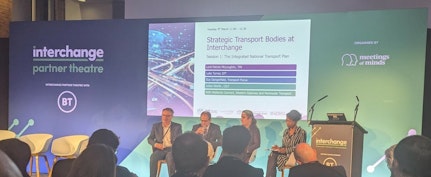
Basemap at Interchange UK 2025
This week we attended Interchange 2025 in Manchester. With 2000+ delegates and over 62 sessions to choose from across two days, there was no shortage of inspiring conversations.

Day 1
A welcome from Rachel Skinner, highlighted the goals and deadlines the industry is facing and the importance of ensuring a common goal in order to tackle problems such as climate change. The topic of devolution was a recurring focus throughout the event beginning with a Mayoral panel made up of Andy Burnham, Tracy Brabin and Oliver Coppard. The presence of a Mayor was stated to set accountability for issues in an area and ensure that these issues were worked on. More power to make changes such as free tickets for under 19s in South Yorkshire allows areas to return pride in the public transport network.
Great to hear from Andy Burnham about the work which has been done in Greater Manchester to facilitate connected journeys and upcoming changes to ticketing making integration smoother between modes. With Mayors for three regions in the north of England, the difference in investment between areas in the north and south of the country was highlighted. Comparisons were made to work in Germany to ensure that all areas have good public transport and not just key cities.
Tracey Brabin presented current work in West Yorkshire to fill the productivity gap in the region with the introduction of mass transit and public control of the buses. With a large young population, key universities and a key area for sectors such as digital technologies and financial profession services, high quality transport is required to encourage further investment in the region and enable it to reach its potential.
Oliver Coppard expanded on the topics regarding the benefits of bus franchising and improvements to active travel and modes in order to unlock the potential of South Yorkshire. He also shared an example of how small changes, made with local knowledge can have a big impact through the example of the Advanced Manufacturing Research centre. This centre contains many large employers as well as training centres with courses from school leavers to graduates, however only 1% of the population of South Yorkshire were able to access the area by public transport. Through improvements to the bus routes in the area, many employees were now able to get to the centre through sustainable modes.

Subnational Transport Bodies – Integrated National Transport Strategy
The next session focused on another big topic of the event, the Integrated National Transport Strategy (INTS). With speakers from Department for Transport, TransportFocus and sub-national transport bodies, there were a range of views and experience. Luke Turner, DfT reflected on the current fragmented and inefficient nature of transport and the hope that the INTS would help to achieve the aim of quality public transport throughout the country and not just key cities. With an intended publication date of autumn 2025, DfT are currently carrying out consultations and a roadshow to gather thoughts on how the INTS should work.
Guy Dangerfield, Transport Focus brought the focus to the passengers and the barriers which must be overcome to allow for an integrated system making public transport a more viable option. These were split between the practical barriers such as a lack of mobility hubs, unintuitive interchanges and the timings of services to emotional barriers such as an awareness of the options available and removing the fear of a missed connection through ensuring there are alternative options at each step of the journey. With multiple different ticketing options being available in different areas, there can be a level of uncertainty about getting a bus in a new area, with ticketing information commonly unknown until you get onto the bus. It is also important to understand that not all journeys are feasible to be made fully by public transport and that the role of Park & Rides should not be underestimated.
Following this, representatives from Western Gateway, Peninsula Transport and Midlands Connect gave their view on the INTS from the perspective of sub-national transport bodies. For example, the importance of the INTS to not be overly prescriptive, with the understanding that all areas are different, and what might work for an urban area would not work in a rural area. The measures of success were also questioned, along with the concern that certain measures can discourage innovation and people become focused on a particular type of solution in other to meet a set goal. With multiple layers making up the transport industry it is also important to understand who is responsible for what, to avoid blurred responsibilities leading to a lack of accountability and roles not being carried out. It is also important that the powers which teams have reflect these responsibilities to allow them to fulfil these responsibilities to their best.

Breaking down data silos, sharing and standardisation
In the afternoon, there was a session dedicated to breaking down data silos. There is an abundance of data within different teams however the existence of this data is not always shared and the data itself shared even less so. Whether this is due to concerns over the quality of the data or assumptions made, concerns over how the data would be used, or teams simply not being aware of how other teams could use the data. One example was given of three teams who were all procuring the same data type from three different sources independently of each other unknowingly and the cost implications and waste that this would have caused if not caught in time. This issue also extends to tools not being shared between teams. We have encountered many cases of people who are interested in TRACC but are not aware that they already have access to it, whether that is through another team or even within their own team!
Whilst larger teams may be able to use economies of scale to acquire data and use it effectively, smaller teams can not make use of these benefits and are more limited on the data they can acquire. Larger bodies such as STBs or national bodies acquiring and sharing this data can help to avoid what was referred to as the “Rutland Problem”. With short term funding and deadlines encouraging short-term thinking, data is typically acquired for just what is needed at the time, instead of getting data to cover a larger range of areas and use cases to cover future use cases as well, again making economies of scale hard to realise. A concern was raised regarding data sharing was the terminology used within the data, which can differ widely between different teams and could lead to confusion over the meaning of the data.
A key issue in the transport industry is not only data sitting on a computer in a single team, but data being held in the head of an experienced team member. This can lead to a loss of information and expertise when that member leaves or retires as this information is not stored anywhere else for the team or others to access.
DataCutter helps you to access multiple different data types such as road and public transport networks, census data and point of interest for an area quickly and easily. This allows you to make use of existing data and have access to all of this in one location. Data can be cut to just the area that you need, preventing you from having to purchase or store surplus data.

Transport Planning Society - Integrated National Transport Strategy
The final session again focused on the INTS but this time with a view on who transport should be integrating with. Whilst integrating transport modes with each other to allow for seamless journeys had previously been the focus, this session also looked at integrations with spatial planning to ensure that new developments promoted sustainable travel through a decide and provide approach.
The latest update of TRACC has included the introduction of the Connectivity Score, this enables you to take into access to multiple types of destinations with different weightings and maximum travel times. This helps you to obtain a measure for overall accessibility by different modes to identify the best areas for development and where additional provision may be required.
The importance of looking at multiple modes was also highlighted when calculating the benefit cost ratio of a scheme, as improvements to one mode can have significant impacts on others. For example, improvement to rail services may increase bus use and reduce car use and therefore congestion in an area. Another consideration was the importance of long-term funding which is essential for areas to make the long-term investments needed for substantial change.

Day 2
Day 2 began with multiple talks at the keynote stage including an overview of the progress so far on Manchester’s Bee Network and an overview of the current themes and tensions in transport. This was followed by hearing about lesser discussed modes in the form of ports and aviation and how the roles that these played in an integrated network. Following on from the previous days discussion regarding the sharing of data, Thomas Ableman spoke about the amount of data which is produced and how this has increase exponentially over time. Comparisons between the transport and technology sector were also made and attendees encouraged to take risks and break the occasional rule in order to allow for innovation.

What works for major cities
Day two contained two related sessions, the first: "What works for major cities"; followed by "What works for small towns and rural areas". The first began with Ryan Lloyd, Deloitte who spoke with multiple transport authorities about their recent successes in improving public transport and the key lessons learnt from these. For example, the need to empower local ownership to get the local community on board with changes and to focus on the customer by improving things such as ticketing and branding to make journeys easier. There was again a focus on necessary long-term funding and acknowledgement that this may require being innovative about funding sources and understanding what improvements to transport can enable.
Followed by Stacey White from West Yorkshire Combined Authority who detailed the plans for mass transit in West Yorkshire and how this would help to connect Leeds and Bradford and reduce the productivity gap in the area. Similarly, Chris Barnes, Transport for Greater Manchester highlighted the importance of transport interchanges to support towns and communities. An example of this was Stockport Interchange which linked the rail and bus stations as well as providing a park, cycle ramp and a residential area. This improvement acting as a catalyst for future regeneration and inspire confidence in potential investors in the area.
TRACC makes it easy to test out different proposals and analyse the impact on these on connectivity. Whether its adding in a new mass transit network, adding a new footbridge to connect a bus and rail station or simply increasing the frequency of a bus route, TRACC allows you to gain the data you need to support your plans and build the necessary business case.

What works for small towns and rural areas
The role of interchanges was also a key consideration when discussing what works in small towns and rural areas, with the projects discussed largely focusing on key interchange locations such as bus and rail stations.
Grace Grant, WSP highlighted the recent funding uncertainty and the hope that this would reduce over the coming months with the completion of the transport infrastructure portfolio review and comprehensive spending review. The change from funding allocations from competitive bids may be of benefit to rural areas who typically have smaller teams and less resources to put towards such bids, as well as areas in the north of England being allocated funding following changes to the scope of HS2.
One of the projects presented was Hereford Station Transport Hub. This project had the goal of converting the station forecourt from largely car parking to a welcoming area for pedestrians, cyclists and bus users. The importance of understanding and celebrating the character of the local area was emphasised to ensuring community support as well as the long-term success of a project. Andrew Atkins shared a similar example of work done at Bishops Stortford to provide a bus interchange, public plaza and new spine road around an existing rail station to enable connections to the local area.
It was clear from the examples and discussions that rural areas tend to require more bespoke solutions, tailored to the specific area and community.

Accelerating the use of AI in transport
The final session of Interchange 2025 focused on the use of AI in the transport industry. With AI becoming more common in our lives, additional tools are cropping up which aim to make tasks easier or provide better solutions. Basemap’s latest tool, EVR, utilises AI to determine the optimum journeys for electric vehicles to multiple destinations, such as delivery vans. This allows the journeys to be easily updated to take into account changes in weather which can have a significant impact on battery life.
The panel agreed to the need for the industry to get on board with AI though concerns were raised about ensuring that the industry start using AI rather than AI simply happening to the industry without input. Comparisons were also made to ticketing, whereas new methods are added the old remain, leading to multiple options being available and no savings being made as a result and the requirement to ensure that the full benefits of AI are realised.
Mirroring his presentation earlier in the day regarding the need for the industry to take more risks and try new things, Thomas Ableman reiterated the need for the industry to make testing new options and methods easier to allow for innovation.
All in all the Interchange UK 2025 event provided great thoughts and discussions surrounding the coming challenges and can't wait to see how the industry faces them over the coming year!